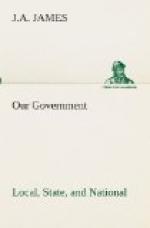8. What was the attitude toward union during the period 1783-1788? Were there notable bonds of union even at this time? What other influences have increased this sentiment? Fiske, Critical Period, 55-63; Walker, The Making of the Nation, 7, 8.
9. President Roosevelt said, in an address delivered April 9, 1902, at Charleston, S.C., “When four years ago this nation was compelled to face a foreign foe, the completeness of the reunion became instantly and strikingly evident.” What is his meaning? How does the statement illustrate the point emphasized in this chapter, that a common danger produces union?
10. Describe the character of the money used in 1783 and succeeding years. What was its influence? Fiske, Critical Period, 162-186.
CHAPTER VI.
THE CONSTITUTIONAL CONVENTION.
Events Leading to the Constitutional Convention.—Among the many difficulties that arose during the period of the confederation were constant disputes between Virginia and Maryland over the navigation of the Potomac River and Chesapeake Bay. Finally, in March, 1785, commissioners from these States met at Alexandria to consider these difficulties. The outcome of the meeting was that Virginia proposed a convention and called for delegates from all of the States to meet to consider how commerce should be controlled. Delegates from five States only were present at Annapolis on the day appointed, September 11, 1786. Nothing permanent could be accomplished with so few States represented. Before adjourning, however, they agreed to a resolution, framed by Alexander Hamilton, which proposed the calling of a convention at Philadelphia to amend the Articles of Confederation.
The Federal Convention, 1787; Delegates.—All of the States, Rhode Island excepted, were finally represented in this, one of the most notable conventions in the history of the world. Among the fifty-five delegates assembled were many who had already been conspicuous in public affairs. They were the choice men of the States from which they came. Twenty-nine of the number were university men. Washington and Franklin were present, and Washington was unanimously chosen president of the convention. Neither of these men took an active part in the debates; but their presence gave inspiration to the other members, and they had untold influence at critical times. Among the ablest members were Alexander Hamilton of New York; James Madison of Virginia; Oliver Ellsworth and William S. Johnson of Connecticut; James Wilson and Gouverneur Morris of Pennsylvania; Rufus King of Massachusetts; and Charles C. Pinckney of South Carolina.




